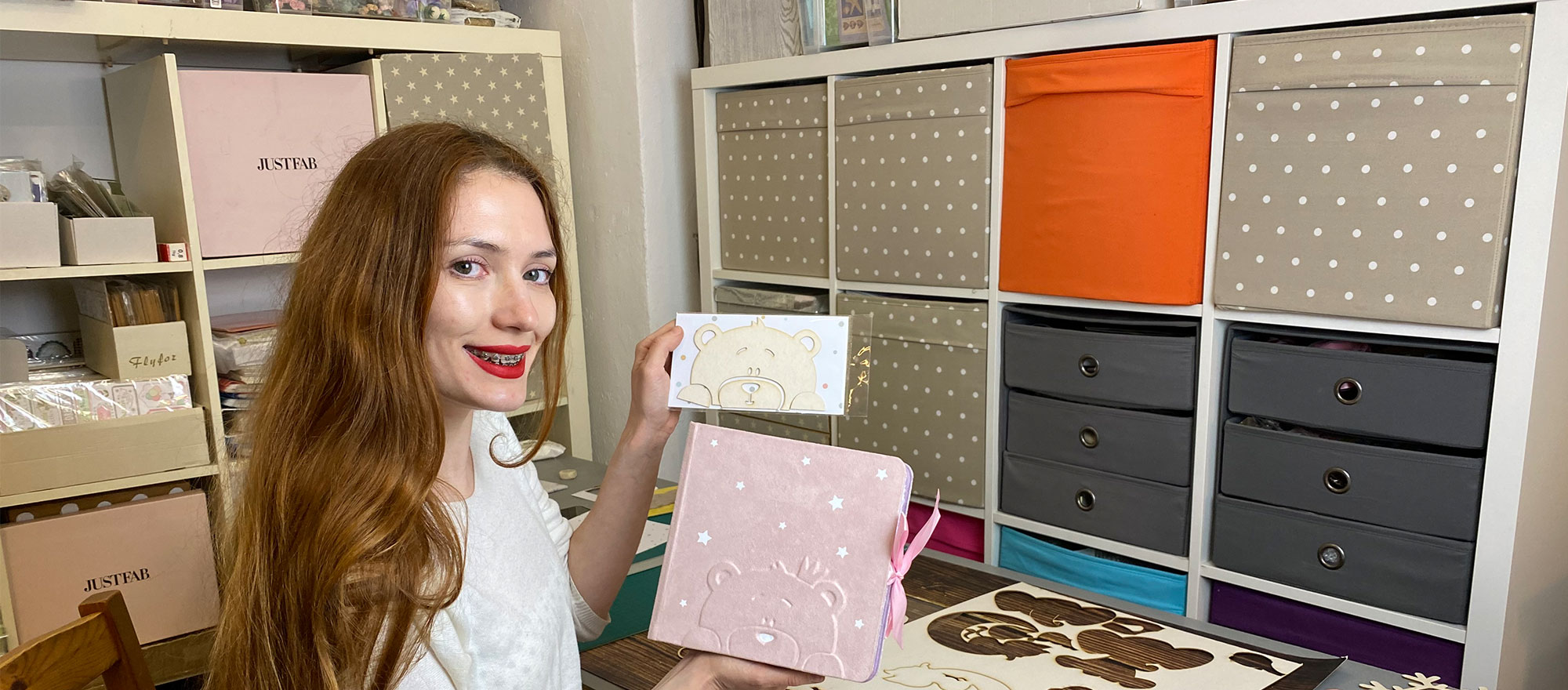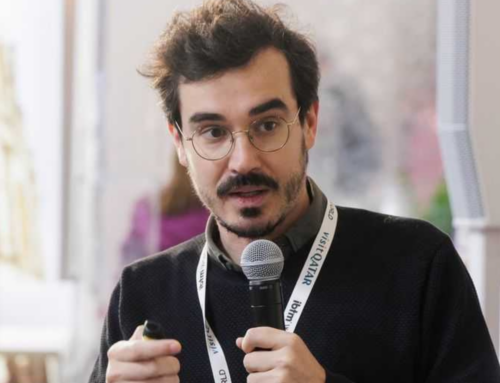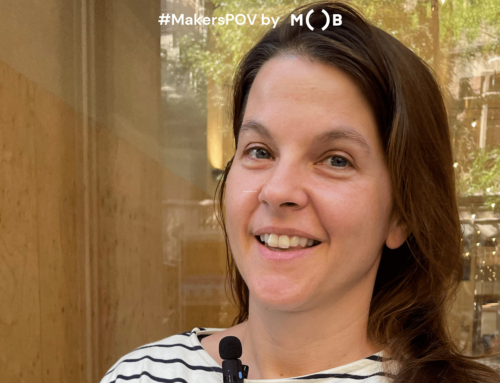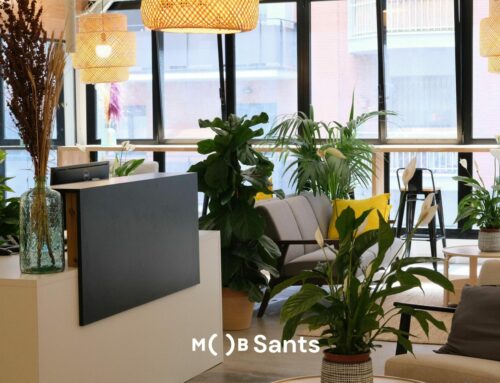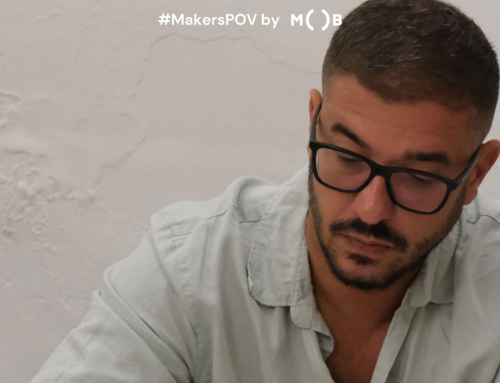This week, we had the pleasure of catching up with Veronika Saraeva, who has been developing the makerspace at MOB – Bailén with her extraordinary range of projects involving everything from jewellery making, to laser cutting vinyl. She tells us how, with the support of FabCafe, the makerspace has become her second home and the community, her family. Veronika wants to build a shared creative space, a makerspace available to the community to create and share knowledge.
Veronika, by the way, I don’t know your last name?
My last name is Saraeva. In fact, I was always embarrassed because in Russia it means a little box where you keep things… and it also sounds like Sarajevo, the city. Then here in Spain I discovered that they are two women’s names 🙂
Tell us a little about yourself, what has been your career as a maker?
I have always liked crafts. My mother sewed, crocheted and did many other things at home, and at school we also did a lot of handicrafts. In fact, I am a beautician by profession, with a European approved degree. I learnt everything from make-up to anatomy, including drawing and painting classes, which are very necessary for precision in make-up. It is the equivalent of a higher degree here, because in order to join the course, you had to take exams in anatomy, drawing, and painting. I started with that when I was 18 years old (I’m 33 now). I worked for several years as a beautician, basically doing facial treatments, but that bored me a bit, so I was always looking to combine my work with more creative courses; I made jewellery, and I also did other more technical courses like Illustrator. I liked discovering things, and on one of my trips I discovered Barcelona.
How long have you been in Barcelona?
I first visited this city nine years ago and I loved it. Two years later, I decided to move and the first thing I did was to take Spanish courses because I could only say “hello, how are you?”… I was immediately invited to work in a Russian beauty salon, they appreciated my precision and attention to detail. Then I discovered the Escola de la Dona, where I studied fashion design for two years. We did stamping, sewing, pattern making, silkscreen printing, sublimation, and I also went to civic centres to do more courses in jewellery, leather art. I have accumulated a lot of things! I have also tried acrylic painting, doll making, soap making, decoupage… the question would rather be what haven’t I tried!
I already had a gallery of creations on my Instagram, but I saw that I needed something more formal to get more out of all my creations, and I decided to open an online store. Another advantage in my favour is that in Russia, since it’s so cold, we spend a lot of time at home, plus women have three-year maternity leave, which gives you a lot of time to learn new techniques for crafting. That’s why many techniques are mastered there that are not yet well known here. I saw that sharing this knowledge could be one of my strong points, besides the fact that there I have more facilities to find the materials at a better price.
With that I started to do online courses and I invited a friend from Belarus to help me, she makes children’s albums by hand, with pop-up and 3D figures. The courses are focused on a Spanish audience, as we also have participants in Latin America. On the Youtube channel we also have free tutorials.
Now what we would like to do is to go back to offline courses in person. Three years ago we did one and people were delighted, it was very cool, we did something very nice but very difficult! In the end it took us 12 hours to finish, even though we were tired, everyone was very happy with what we had done!
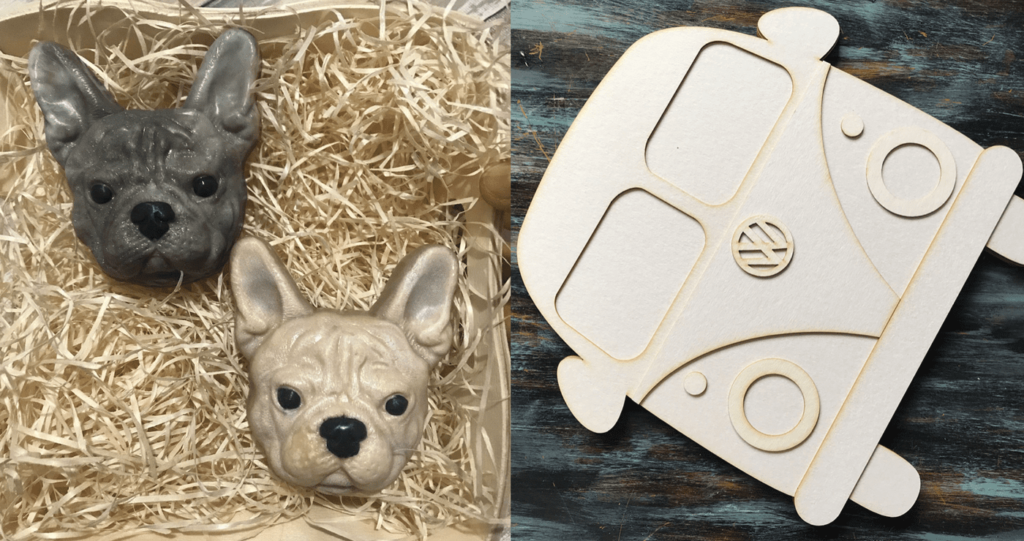
Was it in the MOB space that course?
No, that was somewhere else. How I got here is a curious story. At the beginning of giving the courses, what I did was to buy the parts already cut from the wholesale manufacturer and offer the kit ready to assemble. Until one day, after giving a free course that was very successful, people wanted to buy the kit material so they could make their van-shaped albums at home. The thing was that just at that time that supplier was on vacation but I had a lot of demand. So I ventured out to find a place where I could cut the pieces myself, and then I found FabCafe. They showed me how to cut everything and I quickly realised the advantages of being able to manufacture; on the one hand not having to rely on logistics, which is easily disrupted by the pandemic situation. On the other hand, almost without realising it, I was starting to create my own brand, with my own designs.
I ventured out to find a place where I could cut the pieces myself, and then I found FabCafe. They showed me how to cut everything and I quickly realised the advantages of being able to manufacture.
With all the facilities that FabCafe gave me to use the makerspace at MOB – Bailén, I started to bring the machines that I already had at home, like the plotter, which allows you to cut the design and then go on to cut vinyl, it is used for example to cut the album cover. I also have the sewing machine and an overlock machine to sew the final details. I have even brought professional lights and backgrounds to take photos or record videos for the web or my networks.
There is a sublimation machine, with a thermal iron. It’s practically a complete kit because with the plotter you cut the design you want, and then with any t-shirt or clothing you already have you place the vinyl, close it and you have your print. I think it could be a good way to start doing face-to-face courses, like one-day workshops. The truth is that I have many ideas, and a lot of knowledge and material that can be used to create; sewing, acrylic painting, watercolour, printing on fabric, decoupage with beautiful napkins … there are thousands of things… it’s difficult to focus on one thing!
Would all that together describe the ideal makerspace for you?
Well, yes and no. There’s a lot of stuff there, tools of all kinds all over the place. I think when you create things with your hands it’s very important that the space is as nice as possible because it has to be able to inspire. I would like to be able to divide it into areas according to the type of machines I want to use, for example. The good thing is that there is a lot of space; the place has so much potential. I really feel like the pioneer of the makerspace and I like to see it evolve little by little. Now, with all the equipment, the next step is to see how to give it more cohesion on an aesthetic level.
Being able to divide home and work is important, plus you are not limited by your four walls, and you also meet people, who become almost like family in your day to day life.
What would be the added value of the makerspace for you, what does it give you the most?
The best thing about having a makerspace is that it allows you to have a workshop away from home. Before I came to FabCafe I was working all day at home, and sometimes it’s sad because you hardly get out of the house, you don’t interact with other people. Since I have been coming here, I feel happy because I can finally separate my home as a space to rest, and my space to work. I think that being able to divide home and work is important, plus you are not limited by your four walls, and you also meet people, who become almost like family in your day to day life. That diversity and cultural richness is very valuable to me. I feel part of the community. There is always someone there to help you. After my time in confinement, I really appreciate and I’m grateful for the opportunity to be here.
